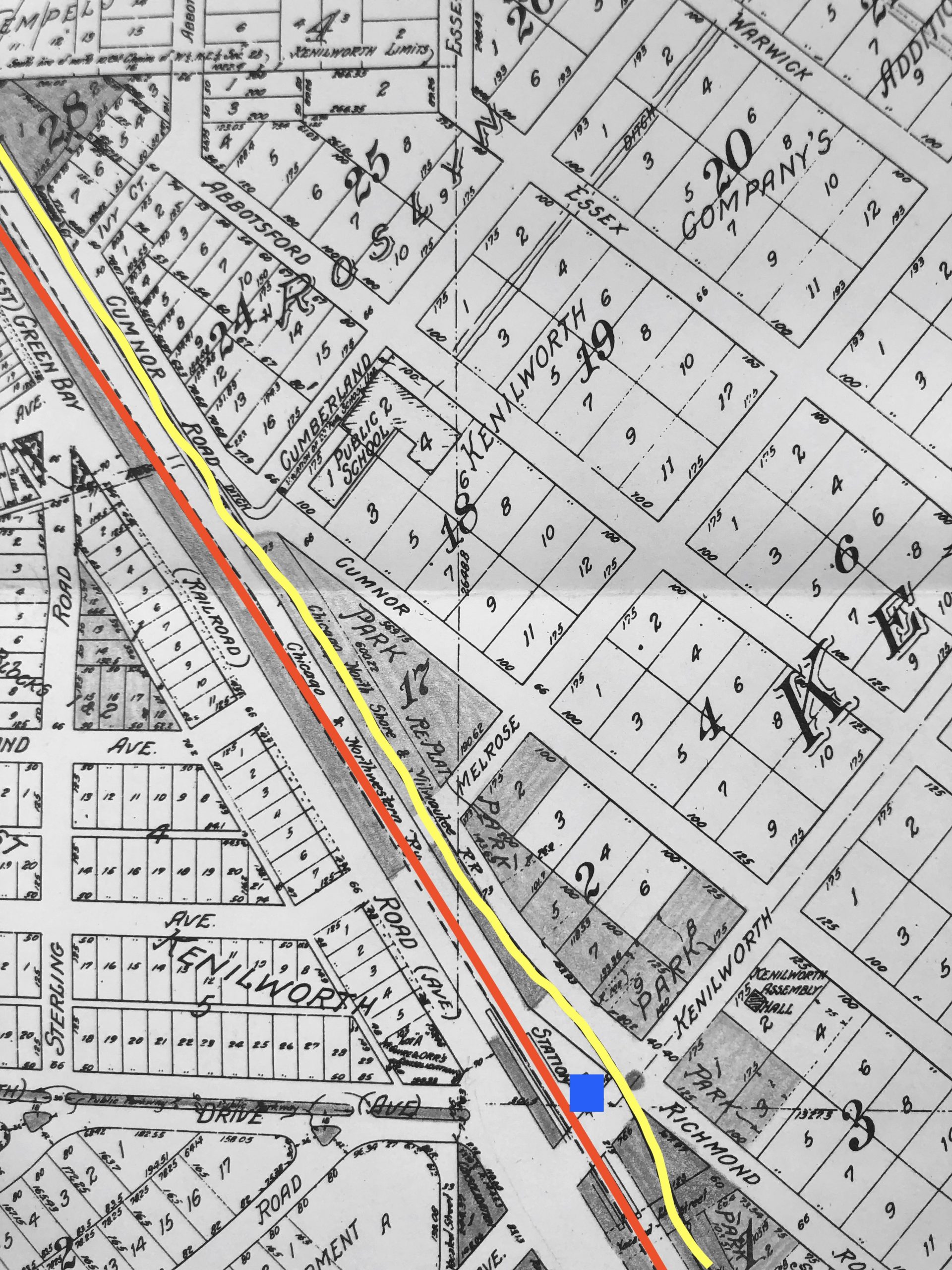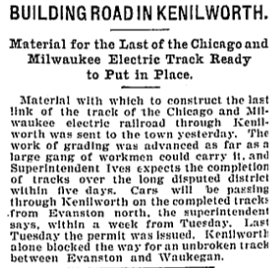Chicago & Milwaukee Electric Railway in Kenilworth

By 1894, an electric railway was established between Waukegan, North Chicago, and Lake Bluff by the Bluff City Electric Street Railway Company.
This railway competed with the Chicago and North Western Railroad (which still runs the Union Pacific/North Metra line today). The Bluff City Company did not last very long and eventually sold in 1897 to A. Frost and George Ball, who renamed it the Chicago & Milwaukee Railway Company. The company quickly began expanding service to other North Shore communities. The Chicago & Milwaukee faced difficulties from both its rival Chicago & North Western Railway Company and North Shore communities, including Kenilworth. In the beginning of 1899, the Chicago & Milwaukee Railway Company completed laying tracks from Waukegan to Chicago with a small gap at Kenilworth. Chicago & Milwaukee was unable to obtain a franchise for operation from Kenilworth’s Village Board due to the need for laying new tracks along what is now Richmond Road, north of Kenilworth Avenue. Not only would the construction of the tracks interfere with public property, the tracks would also have to run through private property owned by Joseph Sears.
The standoff was serious enough that police officers were posted at the rail’s terminal and railway workmen were warned off private property. Even though the tracks were not complete through Kenilworth, the North Shore Line did not stop its operations. Passengers were required to take horse-drawn taxis between Wilmette and Winnetka to connect with lines on the north and south sides of Kenilworth. This raised tensions with passengers, between villages, and even the residents of Kenilworth began to worry that they would experience troubles arising from the crowds gathering at the terminal as they waited for their taxis.

The issue resulted in a condemnation suit against the Sears tract at Kenilworth Avenue and numerous, long talks with the Village of Kenilworth to gain consent to lay tracks across the streets. The issue began to resolve on July 17, 1899 when the Kenilworth Company, which Joseph Sears was the sole owner of at this time, sold the required land to the Chicago & Milwaukee Electric Railway Company for $22,500. The money didn’t all come at once though, the Electric Railway Company paid Joseph Sears $1500 for signing the contract, then another $5000 upon delivery of the deeds and title to the properties. Finally, they agreed to pay the remaining $16,000 upon the passage of an ordinance by the Village of Kenilworth, granting the Electric Railway Company the rights to lay the tracks through the rest of the village.
Kenilworth’s Village Board held two special meetings on July 18 and July 19 to consider an ordinance submitted by the Electric Railway Company that would grant them “the right, permission and authority to locate, construct, lay down, maintain and operate a system of Electric Railway lines upon certain streets and parts of streets in… Kenilworth.” The ordinance passed unanimously with many restrictions as to how the Electric Railways Company can construct their tracks, only giving them until October 1 to complete construction and begin operation of the North Shore Line through Kenilworth. The Electric Railway Company gave the village $12,000 to accompany the passage of what became Kenilworth’s 35th ordinance.
The money given to the village was to be spent on beautifying the railway entrance along Kenilworth Avenue. The architect George Maher was brought on to design the fountain as well as the stone benches and urns that are seen today at the intersection of Kenilworth Avenue and Richmond Road. Of the $12,000 only $3500 was spent for the fountain, benches, and urns.
The North Shore Line became known as the fastest interurban line in the country, providing high speed service from Waukegan to Hammond, Indiana. After coming under new management in the 1940s, which opted for buying buses to replace the line, ridership fell and schedules were reduced. The last train ran on July 25, 1955. Since then, the tracks have been removed and replaced by the Green Bay Trail.

Sources:
Chicago Daily Tribune. Shore Line Raises $1,500,000: Chicago and Milwaukee Trolley Road Floats a Big Mortgage – To Reach Kenilworth on Sunday. July 13, 1899. Pg. 5
Chicago Daily Tribune. Try New Trolley Line. July 17, 1899. Pg. 12
Chicago Daily Tribune. Building Road in Kenilworth. July 21, 1899. Pg. 5
Chicago Daily Tribune. Recent Sales, Leases, and Loans. Aug 6, 1899. Pg. 26
Chicago Daily Tribune. Blame Laid On Franchise War: Kenilworth’s Franchise Fight. Nov 19, 1899. Pg. 6
Chicago & Milwaukee Electric Railway Company and Kenilworth Company Agreement. 1899. Kenilworth Historical Society, AR-2002.17.5
Chicago & Milwaukee Electric Railway Company and Village of Kenilworth Agreement. 1899. Kenilworth Historical Society, GRF.IX.1.4
Kenilworth Village Board. Kenilworth Village Board Meeting Minutes (1896-1915). 1896-1915. Kenilworth Historical Society, GRF.IX.1.11
